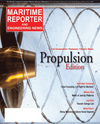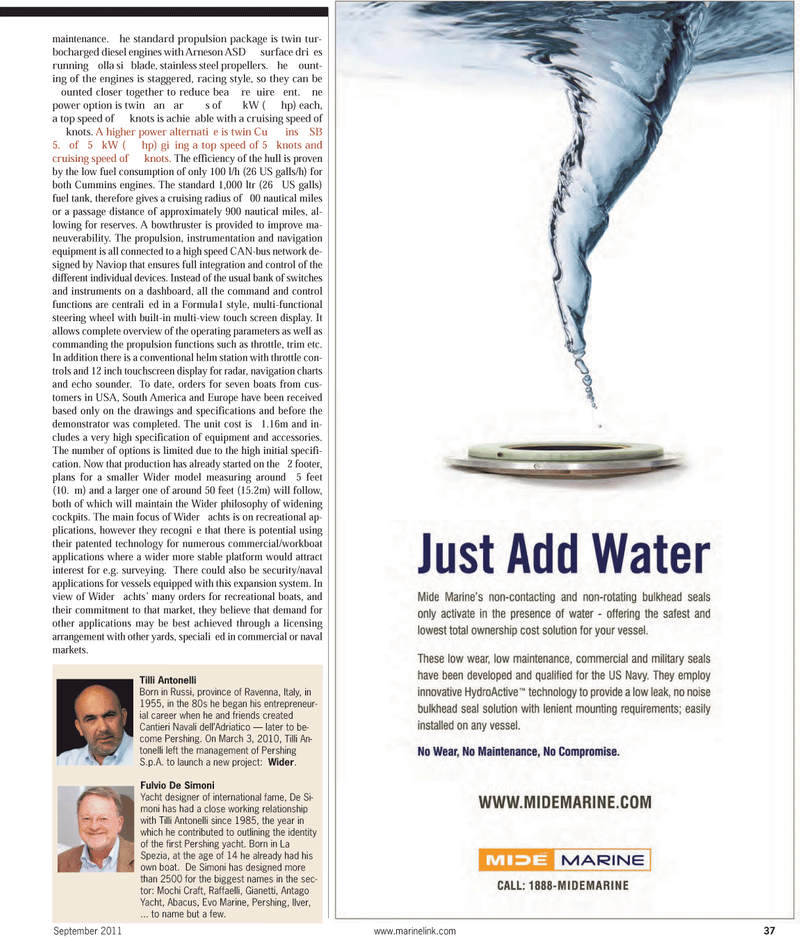
Page 37: of Maritime Reporter Magazine (September 2011)
Marine Propulsion Annual
Read this page in Pdf, Flash or Html5 edition of September 2011 Maritime Reporter Magazine
maintenance.he standard propulsion package is twin tur- bocharged diesel engines with Arneson ASD surface dries running olla si blade, stainless steel propellers. he ount- ing of the engines is staggered, racing style, so they can be ounted closer together to reduce bea reuireent. ne power option is twin anar s of kW (hp) each, a top speed of knots is achieable with a cruising speed of knots. A higher power alternatie is twin Cuins SB 5. of 5 kW (hp) giing a top speed of 5 knots and cruising speed of knots. The efficiency of the hull is proven by the low fuel consumption of only 100 l/h (26 US galls/h) for both Cummins engines. The standard 1,000 ltr (26 US galls) fuel tank, therefore gives a cruising radius of 00 nautical miles or a passage distance of approximately 900 nautical miles, al-lowing for reserves. A bowthruster is provided to improve ma- neuverability. The propulsion, instrumentation and navigation equipment is all connected to a high speed CAN-bus network de- signed by Naviop that ensures full integration and control of the different individual devices. Instead of the usual bank of switches and instruments on a dashboard, all the command and controlfunctions are centralied in a Formula1 style, multi-functional steering wheel with built-in multi-view touch screen display. It allows complete overview of the operating parameters as well as commanding the propulsion functions such as throttle, trim etc.In addition there is a conventional helm station with throttle con- trols and 12 inch touchscreen display for radar, navigation charts and echo sounder. To date, orders for seven boats from cus- tomers in USA, South America and Europe have been received based only on the drawings and specifications and before the demonstrator was completed. The unit cost is 1.16m and in- cludes a very high specification of equipment and accessories. The number of options is limited due to the high initial specifi- cation. Now that production has already started on the 2 footer, plans for a smaller Wider model measuring around 5 feet (10.m) and a larger one of around 50 feet (15.2m) will follow, both of which will maintain the Wider philosophy of widening cockpits. The main focus of Wider achts is on recreational ap- plications, however they recognie that there is potential using their patented technology for numerous commercial/workboat applications where a wider more stable platform would attract interest for e.g. surveying. There could also be security/naval applications for vessels equipped with this expansion system. In view of Wider achts? many orders for recreational boats, and their commitment to that market, they believe that demand for other applications may be best achieved through a licensing arrangement with other yards, specialied in commercial or naval markets. Tilli Antonelli Born in Russi, province of Ravenna, Italy, in 1955, in the 80s he began his entrepreneur- ial career when he and friends created Cantieri Navali dellAdriatico ? later to be-come Pershing. On March 3, 2010, Tilli An- tonelli left the management of PershingS.p.A. to launch a new project: Wider .Fulvio De SimoniYacht designer of international fame, De Si- moni has had a close working relationship with Tilli Antonelli since 1985, the year inwhich he contributed to outlining the identityof the first Pershing yacht. Born in LaSpezia, at the age of 14 he already had his own boat. De Simoni has designed more than 2500 for the biggest names in the sec-tor: Mochi Craft, Raffaelli, Gianetti, Antago Yacht, Abacus, Evo Marine, Pershing, Ilver, ... to name but a few. September 2011www.marinelink.com 37

 36
36

 38
38
